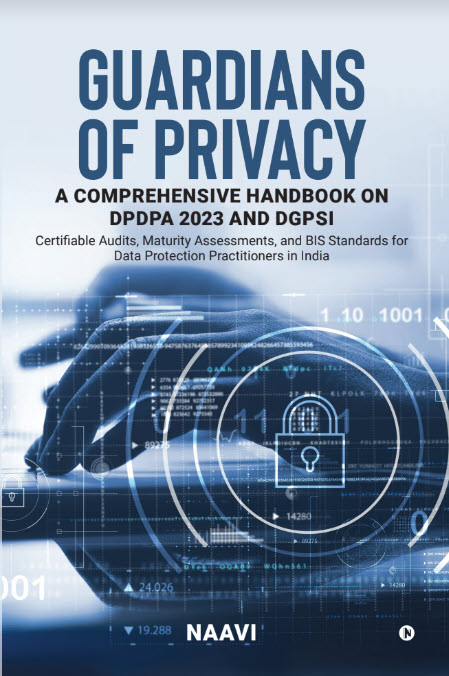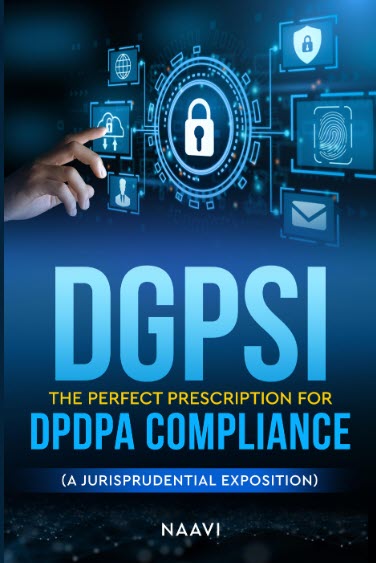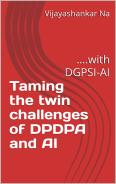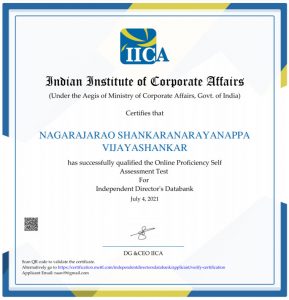I am reproducing below a notice being sent to NIXI in response to their notice related to the acquisition of the domain name dpdpa.in. The notice was sent by Ujvala Consultants Pvt Ltd which is the registrant.
This is placed in public domain so that any body else who is affected by similar arbitrary acquisition of dot in domain names may also take appropriate action.
Quote:
To
.IN Registry
National Internet Exchange of India (NIXI)
B-901,9th Floor Tower B, World Trade Center
Nauroji Nagar
New Delhi 110029
Subject: Objection to your Undigitally signed E-Mail dated August 1, 2025 to naavi2011@gmail.com, regarding the domain name dpdpa.in
Sirs
I am Vijayashankar Nagaraja Rao, popularly known as Naavi, a resident of Bengaluru at the above address and Managing Director of Ujvala Consultants Pvt Ltd. I refer to your above E-Mail and regret to note that you have unilaterally notified that the domain dpdpa.in registered in our name is placed under server lock and you would initiate transfer of the domain thereafter.
In the email, you have also indicated that “Govt of India” desires to get the domain name registered for itself. However you have not given any copy of any gazette notification in this regard. Hence your claim is completely arbitrary, unjustified and illegal. It violates the Constitutional Rights under Article 300A of the Indian Constitution.
I strongly object to this unilateral, arbitrary and illegal decision and give notice that I intend challenging this in an appropriate Court unless the order is withdrawn immediately.
I also give you notice that I refuse any arbitration proceedings under clause 11 of the Terms and Conditions cited by you which is again unsigned and unauthenticated, since you have a vested interest in the arbitration proceedings and the dispute is not related to registration of domain name raised by a member of the public. I am an individual resident of Bengaluru and the impact of your decision is on me at my place while you are an agency of the Government of India with all India presence and hence I reserve the right to file Court proceedings at Bengaluru and the Jurisdiction for the litigation is considered as Bengaluru.
I reserve the right to claim compensation for any damage caused due to this arbitrary and illegal decision of the registry which I may specify at the appropriate time.
It is possible that some body else may also consider this as a “Public Interest Litigation” since this move directly introduces an uncertainty in the dot in domain name registration if the Government acts in such arbitrary manner. I leave it to such persons to proceed separately.
I note that there is no information on whether you have moved similar proceedings against all domain name extensions of “dpdpa” such as dpdpa.com, dpdpa.net, dpdpa.co.in and other 315 country codes as well as confusing domain extensions such as dpdpa-india or any other typographical configurations such as dpdp-act.in etc., dpdp4india.in . Hence your action is discriminatory and points to a possible ulterior motive.
The domain name system provides for registration of dpdpa.gov.in which is reserved for Government organizations and it was your duty to suggest to Government of India if there was a request that they should operate on dpdpa.gov.in.
The proposed move of NIXI to usurp the domain dpdpa.in is similar to the acquisition of property of a citizen and conflicts with the provisions of the Indian Constitution under Article 300A amongst others and hence is a subject matter for litigation as a violation of the Constitutional rights of a citizen of India. Th domain name cannot be arbitrarily acquired without proper reason and offer of adequate compensation.
I am an observer of Domain Name related developments in the globe even before NIXI was born and has always considered the Government of India a friend. However this move of NIXI appears to me like a betrayal similar to what Donald Trump exhibited against India.
It is my desire that wiser counsel prevails and NIXI drops this notice and advises the Government to register www.dpdpa.gov.in
Way back around 2005, I have suggested a system called “Look Alikes”, to ensure co-existence of similar looking domain names with appropriate mutual disclosures. The concept is still visible on www.looaklikes.in . I am myself living with such a conflict between my primary site www.naavi.org and www.naavi.com which is presently owned by an Australian Company and several other similar names including www.navi.co.in which is a phonetically similar domain name. I will provide similar disclosure on the site www.dpdpa.in if Government decides to open a separate website www.dpdpa.gov.in.
If however NIXI does not recognize the rights of Indian citizens to register an available domain name and use it, NIXI will be responsible for diverting registrations in the dot IN domain extension to dot Com extension. This will be an adverse decision on the Indian national interests which would be more to the liking of the opposition political parties and not the ruling nationalistic Government of Mr Narendra Modi.
I consider that it is possible that the current move is deliberately instigated by some wrong advise. If so, this would be an indication of corruption at the Government which will be subject matter of an investigation which will include a report on how many domain names of criminals are being accommodated by NIXI even after they have been notified either by activists like us or by the Home Ministry without taking any action and the possible consideration for the same.
I also refer to the news reports in 2005 such as the report in times of India: “Domain Squatters threat to ‘.in’”, many of which were registrations in violations of the dot in registration but was ignored by NIXI.
I have myself urged NIXI to protect domain name owners in the Net4India fiasco which you have failed to do. Other agencies have pointed out the large number of registrations by foreign firms even at the beginning of the dot in domain names which was also reported in naavi.org at that time.
NIXI has failed to fulfil its duty to the public by taking action against such fraudulent domain name registrations or closure of Net4India.com and become vicariously liable though no proceedings have so far been initiated.
A proper investigation may reveal many other instances of negligence and deliberate mismanagement of the dot in domain registration system which are being left unpursued by activists because NIXI is considered part of the nationalistic movement of bringing domain registrations to the Indian jurisdictions though commercially it is still beneficial to register dot com instead of dot in domain names.
It is possible that some body may now be interested in diverting dot in registrations back to dot com space for a reason known to NIXI itself.
I draw attention to your notice in which you have cited the clause 12 of the terms and conditions as follows.
12. Reservation of Rights for the .IN Registry:
The .IN Registry reserves the right to instruct its Registry Services Provider to deny, cancel, transfer or otherwise make unavailable any registration that it deems necessary or place any domain name(s) on registry lock and/or put a domain name on hold in its discretion:
(1) to protect the integrity and stability of .IN Registry;
(2) to comply with any applicable laws, Indian government rules or requirements, requests of law enforcement, in compliance with any dispute resolution process;
(3) to avoid any liability, civil or criminal, on the part of the .IN Registry, as well as its affiliates, subsidiaries, officers, directors, representatives and employees;
(4) for violations of this Agreement; or
(5) to correct mistakes made by the Registry or any Registrar in connection with a domain name registration. The Registry also reserves the right to freeze a domain name during resolution of a dispute pending before arbitrator(s) appointed under Registry ís Domain Name Dispute Resolution Policy and/or a court of competent jurisdiction.
I donot see any of the above five reasons justifying your action related to dpdpa.in. I demand that you present appropriate authenticated evidences before you take any penal action and prove them in a court of law along with a copy of the specific Gazette Notification for acquiring the domain name property dpdpa.in from Ujvala Consultants Pvt Ltd.
It is a very unproductive exercise for professionals like us to pursue such disputes but in the interest of ensuring that institutions of the Government function properly, it is also our duty. Hence with lot of discomfort and pain, I am sending this notice. This is similar to the Tax terrorism faced by honest citizens, undesirable but without an option.
I request NIXI to look at the larger implications of such acquisition of domain name, the adverse effect it would have on future domain name registration in the dot in domain extension and the discredit you are bringing to Mr Modi’s Government with this “Emergency Like” operation and withdraw this notice forthwith.
In the larger interest of the Indian Citizens, I will be placing this notice for public information along with your response, positive or negative.
Yours sincerely
Na.Vijayashankar
Managing Director
Unquote:







